We have been recently featured on the BBC programme “Autum Watch”. Programmes like this really lift the profile of the Seahorse Trust and it also gives us a real opportunity to be involved with many other marine biologists and conservationists like Nick Baker, Kate Humble and Simon King. Their knowledge is inspirational and they have the ability to get their message into millions of homes which can help highlight conservation groups in the UK like us.
On Saturday the 28th of August Seahorse Trust divers found the smallest Seahorse on the site since the survey started.
The female Spiny Seahorse who is only about 2 months old would have been born in June of this year and it is fantastic news. Over the years of the survey we have found adults, including pregnant males and juveniles and we knew they were giving birth on the site but we always wondered where the babies (fry ) went to and know we know they remain on the site but are very difficult to see. Despite the awful weather on Saturday (1 metre visibilty) this pretty ,small Seahorse was seen clinging to a piece of seagrass. The trust researchers managed to take measurements and some photographs before it set sail deeper into the seagrass bed,
At this age the fry will be looking for the best areas to feed and set up their territories and subject to no other Seahorse being in residence they will set up home and hold this territory until the first of the storms come in the Autumn when they move into deeper safer waters.
Out of the 3 to 5 hundred fry born to each male every month less than 2 or 3 will survive to adulthood due to predation by all sorts of fish species. Seahorse fry are a nice bite sized piece of food for them. In turn Seahorse fry eat a staggering 3,000 plus pieces of plankton every 24 hours.
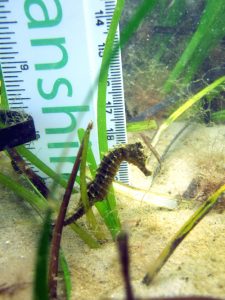
The 4cm fry being measured on the seagrass.
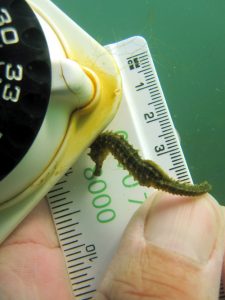
On Tuesday the 10th of August Countryfile came down to our study site at Studland to film the work we are doing with tagging the Seahorses. Trust director Neil trained Ellie prior to the dive to be able to hold the Seahorses without stressing them so that he could photograph the profile pictures of each of the Seahorses so that it could be added to the database. The data being gathered about this unique colony of Seahorses is allowing the trust to help put the information into management plans for Studland Bay in Dorset and the other Seahorses around the British Isles.
The tagging work is done under very strict conditions as part of the Trusts license and anyone wanting to work with Seahorses in the wild in England need to have a license to film (or photograph) or work with them.
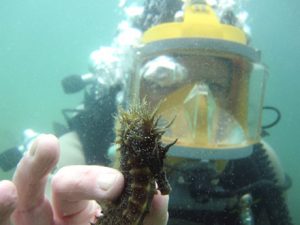
Ellie holding one of the Spiny Seahorses ready to have its profile picture taken
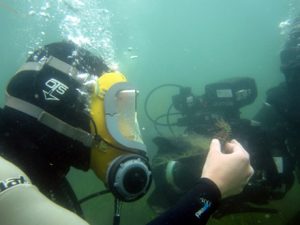
Ellie talking to the camera explaining about the work of the trust
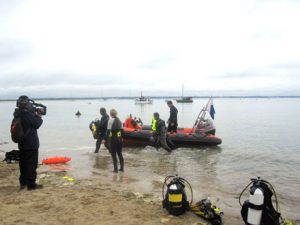
The film crew working in the pouring rain and wind
The Countryfile programme is to be aired on Sunday 22nd of August 2010 on BBC One.
Karen Carruthers has set up a fantastic new design company called Blue Seahorse. Karen has been inspired by these fantastic creatures for many years and decided to name her new company after them.
She has a superb Blue Seahorse Logo based on the Spiny Seahorse found here in the UK and particularly at our study site in Studland in Dorset.
For any design needs check out Karens website which will be up and running in 2 weeks
The Isle of Purbeck Aquarium in Wool in Dorset run by Tim and Barbara have kindly sent the trust a donation of £70 collected from their visitors and customers.
They have a small dedicated room showing various fish species from the region and also have a tank of captive bred Seahorses to educate the public about these amazing creatures. You can also see tanks of fish fry where Tim and Barb are doing a series of captive breeding projects.
Tim and Barbara have been very supportive and are great friends of the trust and it’s work for many years and we would like to thank them for their continued support of our work.
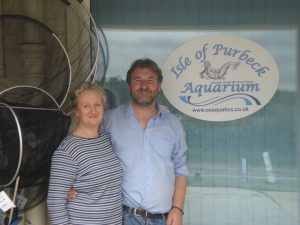
East Dorset Open Water Swimming Club held its second annual Seahorse Challenge Open Water Swimming Race at Knowle Beach, Studland, Dorset on Sunday 26th. June. This annual event held under British Long Distance Swimming Association rules and over a 3.8kms course is called the Seahorse Challenge race after the breeding colony which exists in the area. The club is very keen to encourage the study and preservation of this magnificent creature and to support the activities of the Seahorse Trust.
This year’s race provided challenging weather conditions for both swimmers and organisers as the beach and sea was shrouded in fog with visibility no more than 200 metres at times. However with a revised course, a very successful swim took place with 120 swimmers from all over the country taking part.
The winners of each race category (men’s wetsuit and non-wetsuit, ladies wetsuit and non-wetsuit) received a magnificent watercolour of a seahorse painted by renowned local artist Heather Brown.
The club is grateful to the RLSS Poole and RLSS Bransksome Lifeguards, the National Trust, St John’s Ambulance and to all its volunteers for their support as without their commitment the event could not have taken place.
Bob Holman
Chairman: East Dorset Open Water Swimming Club
The Seahorse Trust is hugely grateful to Bob and the club for raising £150 towards our work at Studland; with their and others kind donations we can go on working towards the protection of the site and the most important colony of Spiny Seahorses here in the UK if not the whole of Eurpoe.
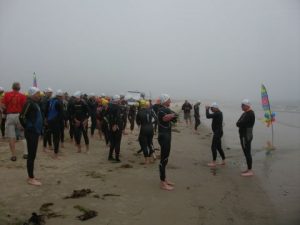
This year is probably one of the worst for damage to the seagrass meadow at South Beach, Studland Bay in Dorset. We have noticed that the size of the mooring chain damage has increased this year with some of the holes measuring some 30 metres across. The mooring chains and blocks that hold the moorings are more exposed than every before and creating desert like conditions where very little lives.
The following pictures (copyright The Seahorse Trust) were taken on Saturday the 31st of July 2010 on site at Studland.
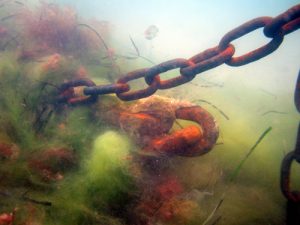
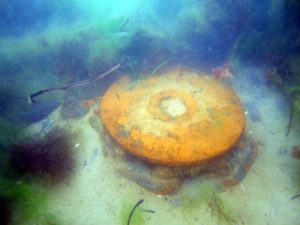
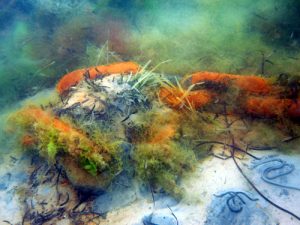
The pictures above show just a few of the mooring chains that are causing extensive danage on the site; these are attached to some of the moorings on the site. The pictue of the round lump of metal is the mooring block one of these moorings is attached to.
These pictures above show the reason why environmentally friendly moorings should be put in on the site to allow boat use without damaging the environment.. This needs to be a case of urgency before the seagrass is damaged beyond repair.
There is another equally serious problem that is occuring at Studland this year and that is the dying off of large areas of the seagrass as can be seen by the pictures below.
The following picture show the seagrass is turning white and dying in large patches.
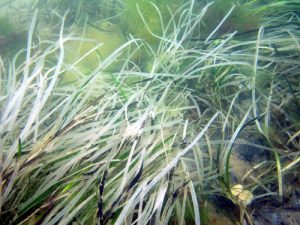
The picture below shows how an anchor has cut through the seagrass which will be undermined by the current and tides causing long term damage to the seagrass meadow.
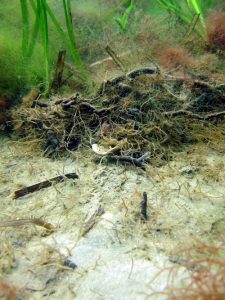
The third and equally damaging process on the site is the anchors that are digging up the seagrass at an alarming rate. If you can imagine having a prisitine lawn and you have 300 plus people digging holes in it, the lawn will soon be destrpyed; this is what is happening at Studland with the anchors but there is an answer to the mooring and anchor problems and that is to put in enviornmentally friendly moorings and ask boat users to use these and not drop anchors or use the exisiting damaging moorings.
Please lobby Natural England and Crown estates to put in these moorings so that we can preserve this site and the seahorses for the future.



Recent Comments